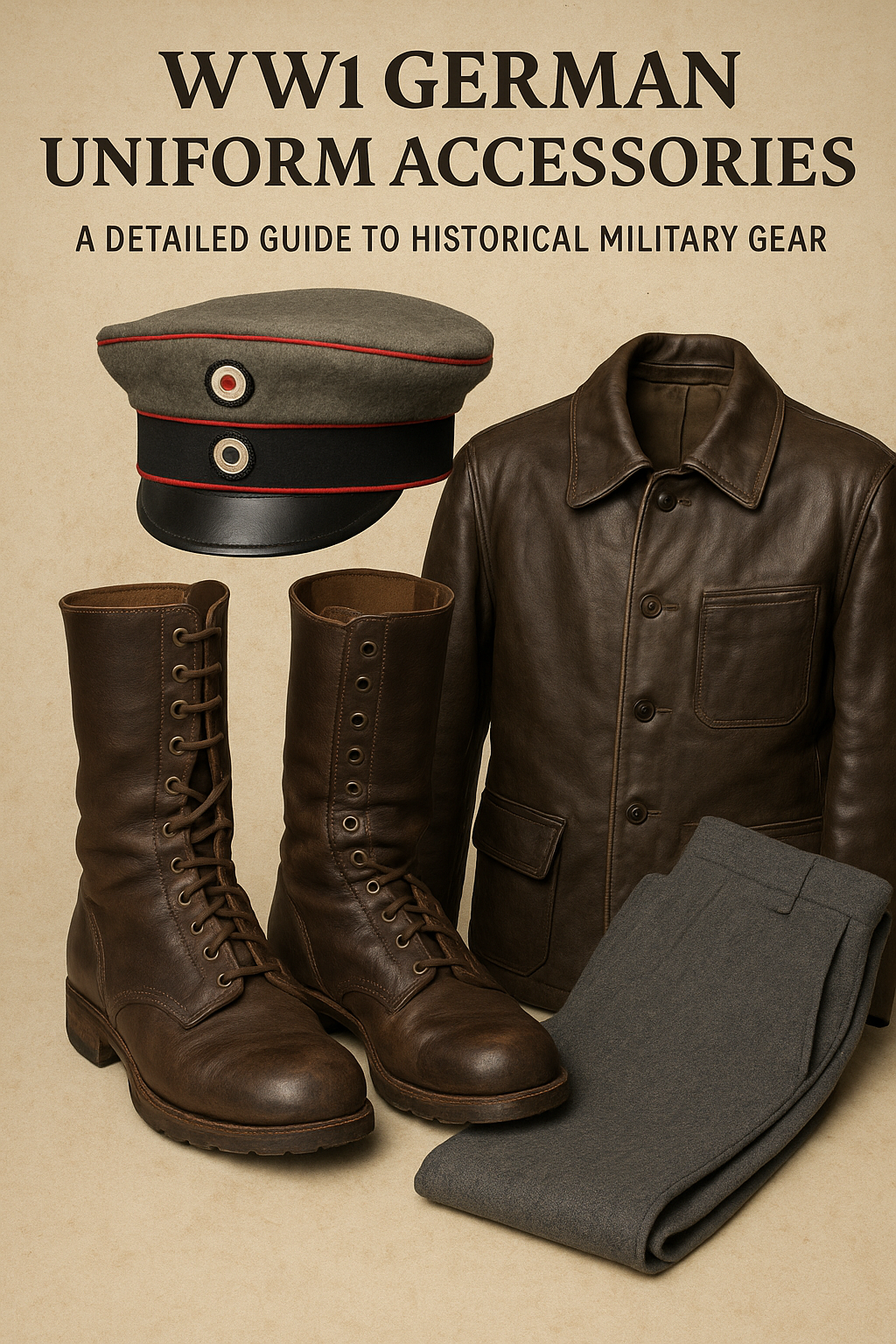
WW1 German Uniform Accessories: A Detailed Guide to Historical Military Gear
Published on Jun 15, 2025
WW1 German Uniform Accessories: A Comprehensive Look into Historic Military Gear
When you think about World War I German soldiers, what comes to mind? The spiked Pickelhaube helmet, the long trench coats, or the stoic discipline? Behind that iconic image lies a well-structured and functional uniform system, complete with accessories that were as practical as they were symbolic. In this article, we'll break down some of the most important WW1 German uniform accessories, including caps, boots, pants, and jackets, giving you a complete picture of the gear worn by German troops during the Great War.
Whether you're a military history buff, a collector, or a reenactor, this guide will walk you through the essential elements of German WW1 uniforms with insights from our curated collection at Paddelaters.com.
1. The German WWI Cap: Function Meets National Identity
The WW1 German field cap (Krätzchen or Feldmütze) was a staple part of the soldier's attire. These soft caps replaced the more ceremonial Pickelhaube in frontline conditions due to their comfort and practicality.
Key Features:
- Typically made from grey or green wool
- Red or colored piping denoted regiments
- National cockade (a roundel in black, white, and red) was sewn at the front
While many associate WW1 with the spiked helmet, the cap quickly became a symbol of life in the trenches. Today, authentic German WWI caps and quality reproductions are sought after by collectors and film producers for historical accuracy.
Browse our WW1 Cap Collection to explore high-quality, hand-crafted models.
2. German Army Pants: Utility and Endurance
Though this guide focuses on WW1, it's important to note that some WW2 trousers retained stylistic elements from the Great War. The German army pants in WW2 often followed similar design principles: durability, warmth, and ease of movement.
WW1 Features:
- Wool construction for insulation
- Tapered legs to fit into boots
- Side buttons or buckles for waist adjustment
Today, reenactors frequently use WW2 German trousers to complete their WW1 load-outs, especially when sourcing original gear is challenging. They offer the same iconic look with minor variations.
Check out our selection of historically accurate German Trousers from WW2.
3. WW1 Army Boots: Marching in Harsh Terrain
Perhaps the most underappreciated but crucial part of the German soldier's kit was his boots. The standard WWI military boots were designed to handle the muddy trenches, cold winters, and endless marches.
Characteristics of WW1 German Boots:
- Known as "Marschstiefel" (marching boots)
- Made from blackened leather
- Reinforced soles with hobnails for grip
Boots were so vital that they often made or broke a soldier's effectiveness. Well-worn boots could cause trench foot, while well-made pairs were often traded or bartered.
Our premium WW1 Army Boots combine authenticity with comfort, ideal for reenactments or collections.
4. Leather Jackets WW2: The Post-War Evolution
While leather jacket WW2 gear became more prominent in the Second World War, their roots lie in early 20th-century military aviation and motor units. These jackets provided warmth and protection, especially for officers and specialized units.
Why Include WW2 Jackets in a WW1 Guide?
- Many post-WWI veterans adapted their old uniforms with modern touches
- Early prototype jackets were used by German officers and pilots
- WW2 styles offer a continuation of German uniform evolution
These leather jackets are popular today not just for reenactments but also as vintage fashion items. Their timeless style and rugged build make them highly desirable.
Browse our collection of vintage-inspired Leather Jackets from WW2 for historically accurate apparel.
5. Accessories That Completed the Uniform
In addition to the main garments, German WW1 soldiers carried a number of uniform accessories that added both utility and symbolism:
Common Accessories:
- Belt and Buckle: Stamped with "Gott mit uns" (God with us)
- Bread Bag: Carried rations and personal items
- Mess Kit & Canteen: Essential for survival in the trenches
- Puttees: Cloth strips wrapped around the lower legs
Each of these items tells a story about the life of a soldier—how they lived, survived, and fought.
6. Historical Importance and Reenactment Value
The WW1 German uniform accessories weren't just practical; they were symbolic of a nation's military philosophy. Today, reenactors and collectors aim to preserve this part of history with accurate reproductions.
At Paddelaters.com, our commitment to quality ensures that each piece reflects historical authenticity while meeting modern craftsmanship standards.
Why Choose Authentic Reproductions?
- Enhances reenactment realism
- Preserves historical legacy
- Increases collection value
Whether you're building a full kit or just adding a cap or pair of boots, every item contributes to keeping the memory of WW1 alive.
Conclusion
Understanding WW1 German uniform accessories is key to appreciating the complexity and character of German soldiers during the First World War. From field caps and boots to leather jackets and trousers, every piece served a purpose and reflected the era's demands.
If you're looking to start or complete your WW1 German soldier kit, explore our authentic collections at Paddelaters.com. Each item is designed with historical accuracy and built for quality—so you're not just buying gear; you're preserving history.
